WHAT'S NEW:
Eruption Confirmed!
New lava (rumbleometer stuck in flow) SE rift zone
(posted 9/1/98)
BACKGROUND:
Technology (ROV, ships, etc.)
Other 1998 Axial cruise reports
EXPEDITION:
Science Objectives
Calendar
Today's Science News
Participant Perspective
Teacher Logbook
EDUCATION:
Curriculum
Teacher Observations
Questions/Answers from sea
MULTIMEDIA:
(video clips, animations, sounds)
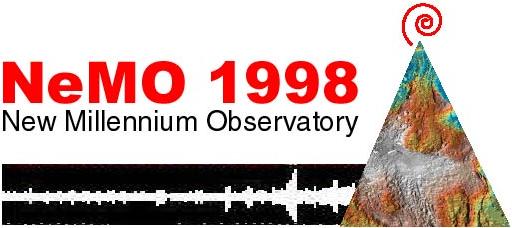
Logbook
September 9, 1998
September 9, 1998
Contents:
Science Report
Daily Science Report - Sep 9
ship's location = 45 51.1N/130 02.3W
Today we had two relatively short ROPOS dives, both at ASHES, and both focused on biological and microbiological sampling. Unfortunately both dives were also terminated early due to equipment problems. The first, dive 471, was terminated after 6 hours because the slurp sampler in-take tube got inadvertently melted when it was held too close to a hot vent. The second, dive 472, was terminated after 7 hours due to problems with the color video camera and the ROPOS telemetry system. While repairs are underway we will be rockcoring until ROPOS is ready to dive again, hopefully around midnight. This time ROPOS will be going back to the upper south rift zone.
Listing of all Science News postings
Life at Sea: Participant Perspective
Geoff Wheat
University of Alaska Fairbanks
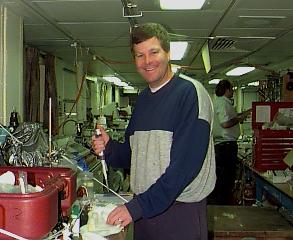
Howdy,
My name is Geoff Wheat. I am a faculty member at the University of Alaska Fairbanks, but unlike most faculty I do not teach. Instead, my duties are to conduct research and to help administer the West Coast and Polar Regions Undersea Research Center.
My research interests focus on the study of seawater circulation through the
oceanic crust, which is similar to the study of groundwater flow through
continental crust. In particular I study the effects of this circulation on the
evolution of the crust and how this circulation concentrates metals to form
deposits. I have studied the effects of seawater circulation within the oceanic
crust along a continuum of geologic settings from new crust on mid-ocean ridge
axes to old crust at subduction zones. By far the most spectacular product of
seawater circulation through the ocean crust is hot springs (>300 degrees C),
such as the ones that are the focus of the NeMO Cruise.
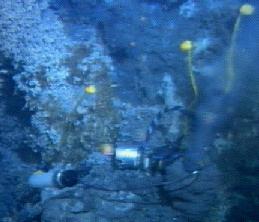
My particular focus for this cruise is to understand how this hydrothermal
system evolves. Fresh magma erupted at this site during the February 1998
seismic event. The heat from this magma drives seawater circulation and
produces hot springs. This circulation also cools the magma, resulting in a
decrease in the rate of flow with time. During this cooling it is inevitable
that changes occur in the physical and geological conditions though which the
seawater flows. This change is then reflected in the chemical and thermal
composition of the hydrothermal fluid. To understand these changes a colleague
of mine (
Hans Jannasch at the
Monterey Bay Aquarium Research Institute) and I
have developed a long-term continuous water sampler ("osmometer" pictured left and below right). This sampler is designed
to collect a sample three times a week for an entire year. We are deploying two
of these samplers this year to be retrieved and analyzed next year.
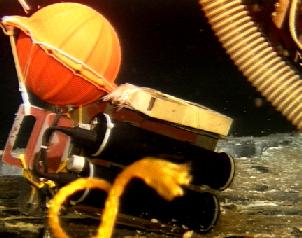
My administrative duties are to promote, fund, and facilitate undersea research through the West Coast and Polar Regions Undersea Research Center (the Center). This Center is one of six centers in the National Undersea Research Program, which is funded by the National Oceanic and Atmospheric Administration (NOAA).
Each year the Center advertises a call for proposals. Academic and government researchers submit proposals that require the use of undersea assets (submersibles, remotely operated vehicles, autonomous underwater vehicles, and SCUBA diving) to solve a particular problem. These proposals are reviewed by scientists with similar backgrounds. The reviews are given to a panel of scientists who then rank all of the proposals. Problems that are addressed by these proposals are very diverse and range from questions concerning fisheries habitat and effectiveness of harvest refugee to the characteristics of faulting along the Oregon and Washington margins and the relationship between this faulting and earthquake potential. The best proposals, such as the one submitted by Bob Embley and Bill Chadwick for a portion of the work that we are now conducting, are then funded by the Center. As a representative for the Center I observe the progress of new technologies and undersea vehicles so that I can inform other scientists who may need undersea tools and vehicles to solve scientific questions related to the sea.
Listing of all Perspectives postings
Teacher At Sea Logbook
Today begins as yesterday ended with the Brown holding station over the vent area called Ashes, and the ROPOS going about the business of examining at close range the biology, chemistry, physics and geology of the sea floor. As a teacher, I always had a special appreciation for Wednesday, the "hump day" when we knew the week was half over, we were "over the hump" , and Friday wasn't far behind. I heard one of the ship's crew use that term out here yesterday. Our month at sea only has 11 days left to go. It's hard to believe that we are that close to finishing this voyage of discovery.
The Brown is "staying on station." Since oceanography became a scientific field of study there has always been the problem of knowing where your ship is with any degree of accuracy. With no landmarks of any kind, it's hard to know where you are. We have come a long way from the chronometer and the sextant, although any competent sailor still carries and knows how to use these venerable instruments to establish his or her location at sea. Modern satellite technology and our Global Positioning System (GPS) have simplified the navigation problem by allowing us at any instant to determine our exact location on the surface of the Earth.
The kind of research that NeMO scientists are doing requires that we not only know where we are and be able to find our way back, but once we find our target, the ship has to be able to maintain it's position for, in our case, hours at a time. In some meteorological studies, the Brown may have to maintain a station for a month or more. Given the waves, winds, and currents that constantly act to move the 3,250 ton Brown every which way, how does the ship maintain a fixed position? If the scientists want to move the ship southwest by west at one quarter knot, how does the crew make that happen? The answer is computers. I was given a great tour of the ship's inner workings today, from the generators that supply the "clean" power for our personal computers to the evaporators that keep us supplied with plenty of fresh water. Again we've come a long way from the days when buckets were set out to collect rain for drinking water.
The heart of the position control system on the Brown is a set of three thrusters, two aft and one in the bow. By changing the speed of the motor driven prop and the direction of the thruster, the ship can be gently nudged in any direction to counterbalance the forces of nature. The three thrusters are constantly operating under the direction of a computer driven navigational system that relies on the GPS readings received on the bridge. This is a job no human being could possibly do. The positioning of the thrusters and the speed of their motors changes on a second by second basis in order to prevent the ship from pulling ROPOS away from its position along the ocean floor. Of course there are limits to any system. In winds above 20 knots it becomes extremely difficult for the system to maintain the exact position required. For this reason, in addition to the difficulty in moving ROPOS onto and off the deck in big waves, scientists generally choose not to put the submarine out in those kinds of conditions.
1600 hours
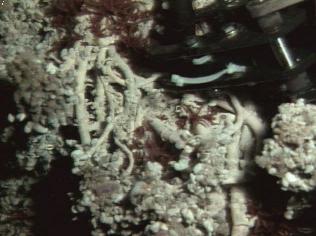
ROPOS had a very long dive last night and today. Chemical and geological samples were collected and the dive ended early this afternoon when nearly every system on board the ROV had developed major or minor problems. As of 1600 hours the ROPOS is on the aft deck being prepared for dive number 473 later tonight or early tomorrow. In the biology lab everything from worms to limpets to pycnogonids (see photo) have been identified, counted and catalogued. The microbiologists have cultured the thermophilic (heat-loving) bacteria on a variety of media, and report that there are many thriving colonies appearing. They may even have found some new critters, but I suspect that DNA tests will have to conducted back on land to prove or disprove this claim.
We are down to ten days left with lots of work yet to be done. Stay tuned.
Logbook of all Teacher At Sea postings
Question/Answer of the Day
Send Your Question to NeMO
(oar.pmel.vents.webmaster@noaa.gov)
Back to Calendar